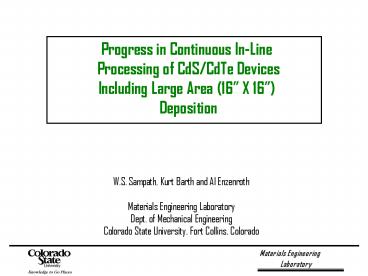Chlorine Issues - PowerPoint PPT Presentation
1 / 20
Title:
Chlorine Issues
Description:
Materials Engineering Laboratory. Dept. of Mechanical Engineering ... SnO:F. Mechanical scribing of CdS/CdTe. films better for low series resistance. ... – PowerPoint PPT presentation
Number of Views:190
Avg rating:3.0/5.0
Title: Chlorine Issues
1
Progress in Continuous In-Line Processing of
CdS/CdTe Devices Including Large Area (16 X 16)
Deposition
W.S. Sampath, Kurt Barth and Al
Enzenroth Materials Engineering Laboratory Dept.
of Mechanical Engineering Colorado State
University, Fort Collins, Colorado
2
Overview
- Process Description
- Device Results
- Characterization Studies
- Scale-up and Large Area
- Processing
2
3
Process Schematic Semiconductor Fab.
- I. Semiconductor Processing
- Vacuum thin film deposition in modest vacuum
- Sublimation of solid materials
- 7 process deposition, annealing and heat
treatment process steps - All process heads similar
- II. Manufacturing efficiency
- Fully lean, automated continuous
- 2 min cycle time
Glass in / Completed device out every 2 min.
3
4
Pilot Scale System for Process Development
4
5
Device Structure
- Device structure
- Glass/ SnOXF / CdS / CdTe / carbon / nickel
- Unmodified window glass substrates
- (Pilkington LOF Tec 15)
Sun Light
Sun Light
Glass Substrate
Glass Substrate
TCO Contact
T
CdS 0.3 microns
CdS 0.3 microns
1.9 microns
1.9 microns
CdTe 1.6 microns
CdTe 1.6 microns
Carbon/acrylic
Nickel/ acrylic contact
Device structure (not to scale)
5
6
Device Performance
- Initial Device Performance
- Routine 11.5 13 efficiency
- NREL verified 12.44
- Long Term Performance
- Devices tested outdoors
- 700 devices tested for performance under stress
- Conditions (temp controlled)
- 65 and 77 C with a 5/8 hr illumination
- 100 C continuous illumination
- One sun
- Desiccated air
Reliability is critical aspect for PV, 20 year
life expected Challenge to determine life
(without testing for 20 years) and develop a QC
technique to ensure manufacture of reliable
modules
6
7
Nine Hour Run with Same Source charge
Efficiency distribution of devices processed over
long duration of system operation with same
source charge CdS, CdTe and CdCl2 . The source
charge materials suitable for industrial
processing.
7
8
Nine Hour Run with Same Source charge
Voc and Jsc during 9 hour processing with the
same source charge for CdS, CdTe and CdCl2.
These devices had no back contact (no Cu doping)
but had the back electrode (sprayed C and Ni
films)
8
9
Pathways to Improve Efficiency
- Low iron white glass to improve current.
- Substrates sent for tin oxide coating by
- APCVD.
- Intrinsic tin oxide buffer layer by APCVD
- and reduce CdS thickness to increase
- voltage and current.
- Alloy CdTe to optimize the bandgap.
9
10
Device Reliability Tests
Outdoor Performance for Optimal Process
Conditions Desiccated, Open Circuit bias
14
12
10
8
Average efficiency
6
4
2
0
0
100
200
300
400
500
600
700
800
900
1000
total time days
- Outdoor Stability Performance
- Excellent performance in outdoor conditions
- Specialized fixture to test cells (no module
issues) - Tests ongoing
- Little or no change on average, even at stressful
open circuit conditions
10
11
Device Reliability Tests
- Accelerated Stress Performance
- Extremely long term testing under stressful
temperature and bias - Efficiency levels
- Tests ongoing.
11
12
SIMS Cu Profiles Before and After Long Term
Accelerated Stress
- Minimal changes in Cu depth profile with stress.
- If device is optimally processed Cu migration
is not a 1st order stability problem
SIMS data S. Asher NREL
13
Results from Thermal Admittance Spectroscopy
Trap activation energy vs initial open circuit
voltage
? Three devices with initial Vocs of 801, 774
and 744 had undetectable TAS signatures
(devices not plotted in the above figure)
? Devices with lower defect activation energies
(Ea) have better light JV performance
13
14
Steady State Photocapacitance Spectrums
- 0.4 V during PHCAP 1 V bias at room temp
and during cool down
- Poor treatment increases trap density over non
treated sample - Optimum treatment decreases trap density over
non treated sample
14
15
Scale up strategy
- I. Step by step approach Developing highly
controlled, - scalable processes and hardware
- Develop detailed understanding of process
- Develop only process that are scalable and
manufacturability and lean - Define process conditions at each stage
3x3 inch pilot process 2 MW/yr.
prod. prototype Large
scale manufacturing
- Each stage of the process defined
- - Substrate temperature
- - Vapor flux
- - Residual gas
15
16
2 MW/yr. system under construction
16
17
Results with the 2 MW system
- Substrate transport with loadlock
- operational
- 2. 16.5 X 16.5 inch substrates heated from
- 25C to 500C in two minutes with
- no glass cracking
- 3. Films deposited on 16.5 x 16.5 inch
- substrates with /- 5 uniformity
- in another setup
- 1.
17
18
Approach for making modules
- Nd-YAg laser promising for scribing
- SnOF. Mechanical scribing of CdS/CdTe
- films better for low series resistance.
- 2. Preliminary results suggest that tempered 3 mm
glass substrates will lead to adequate resistance
to hail impact. - 3. Modeling of moisture transmission suggests
that glass/EVA/glass package with Truseal solar
edge tape will be adequate.
18
19
Conclusions
- Consistent device performance demonstrated in
continuous in-line processing of CdS/CdTe
devices. - Optimum processing leads to stable SIMS copper
profile. - Optimum CdCl2 treatment leads to lower defect
densities as measured by TAS (thermal admittance
spectroscopy) and PHCAP (photocapacitance). - 4. Rapid heating of 16.5 X 16.5 inch substrates
and uniform film deposition demonstrated.
19
20
(No Transcript)































